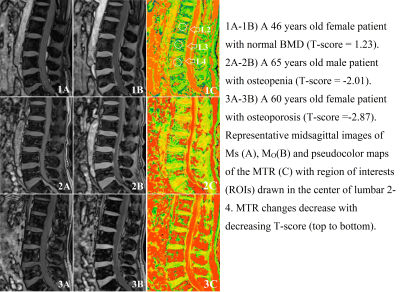Fan Qiuju1, Tan Hui1, Yang Zhen1, Yu Nan1, Yu Yong1, Wang Shaoyu2, Xue Yu3, and Li Yue3
1Affiliated Hospital of Shaanxi University of Chinese Medicine, Shaanxi, China, 2MR senior scientific marketing specialist, Shaanxi, China, 3Shaanxi University of Chinese Medicine, Shaanxi, China
Synopsis
This study aimed to assess the association
between the magnetization transfer ratio (MTR) value and bone mineral density
(BMD) in lumbar vertebral among normal, osteopenia and osteoporosis. The MT
technique was used to evaluate 26 healthy volunteers, 26 osteopenia patients
and 24 osteoporosis patients. The MTR in the osteoporotic, osteopenic, and normal BMD groups were statistically significant
differences. Therefore, MT technique provide quantitative information about the
contribution of macromolecules., which can be used as a non-invasive quantitative monitoring MRI tool for
osteoporosis progression.
Introduction:
Osteoporosis has become a global public
health problem and cutting-edge research problem. Magnetization Transfer (MT)
technique can provide quantitative information of macromolecules. However, the
role of MT used in osteoporosis remains unclear. The aim of this study was to
assess the association between the magnetization transfer ratio (MTR) value and
bone mineral density (BMD) in lumbar vertebral among normal, osteopenia and
osteoporosis at 3T MRI.Methods
From September 2018 until
February 2019, 76 patients, who underwent QCT of the lumbar, were divided into
three groups based on T-score, including 26 healthy volunteers (12 male, age= 45.9 ± 10.7 years, T-score = 0.15 ± 0.83), 26 osteopenia patients (11 males, age= 54.2 ± 10.3
years, T-score = -1.84 ± 0.29) and 24
osteoporosis patients (9 males, age= 61.0 ± 9.5 years, T-score = -3.32 ± 0.68 )
were enrolled. Data were collected on a 3T MR scanner (MAGNETOM Skyra, Siemens
Healthcare, Erlangen, Germany) with an 18-channel table-mounted spine matrix
coil. Besides
general protocols, the sagittal flash 2D
sequences were scanned for two times, one with the MT preparation ( Ms) and the
other one without it ( Mo), the parameters details are: TR = 405 ms, TE = 3.69
ms, Flip Angle (FA) = 70°, Integrated Parallel Acquisition
Techniques (iPAT) = 2 and spatial resolution = 1.1 × 1.1 × 3
mm, bandwidth = 250 Hz/pixel, acquisition matrix = 192 × 192, FOV = 280 mm, number of sections = 15. A total
of 2:58 min to acquire both Mo and Ms data. The regions of interest (ROIs) was
applied in lumbar 2 - 4 (areas 1.0 cm2 ) in sagittal Mo
and Ms images. The MT effect is conventionally quantified by the MT ratio (MTR): MTR =
(Mo − Ms) / Mo × 100%. One-way
ANOVA were performed to evaluate the significance of the MTR between different
groups.Results
The
MTR in the
osteoporotic, osteopenic, and normal BMD groups were (3.67 ± 2.61), (7.50 ± 4.57) and (12.71 ± 7.50), respectively, with
statistically significant differences (P < 0.05). We found that there was a statistically significant positive correlation
between T-scores and MTR existed ( r = 0.854, P <0.001 ).Conclusion
The MT technique has
the ability to provide quantitative information about the contribution of
macromolecules to MR signals. The MTR value can be used as a biomarker for the
progression of osteoporosis.Acknowledgements
NoneReferences
None
